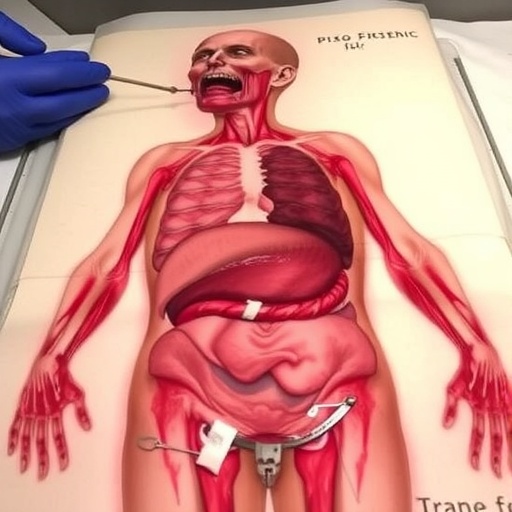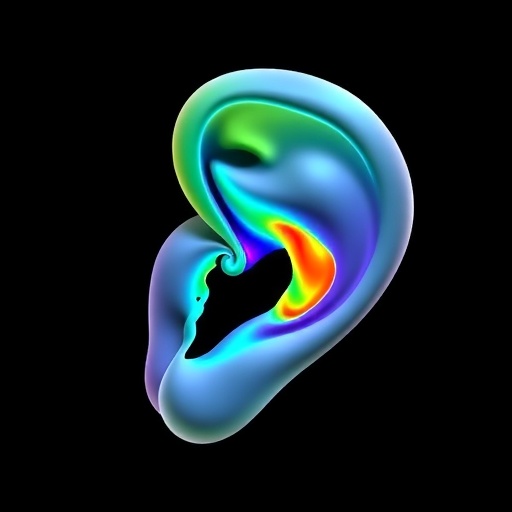In a pivotal advancement for forensic pathology and infectious disease surveillance, a recent study delves deeply into the postmortem testing of bloodborne viral pathogens—specifically HIV, hepatitis B virus (HBV), and hepatitis C virus (HCV)—across autopsy samples. The research, conducted by Sharma, Parmar, Ganju, and colleagues, bridges critical gaps in the understanding of viral persistence and detection postmortem, with significant implications for both public health monitoring and medicolegal investigations. This comprehensive inquiry, published in the International Journal of Legal Medicine in 2025, underscores the intricate dynamics of viral detection in deceased individuals and highlights the nuances that influence the accuracy and reliability of such testing.
The study focuses on evaluating the presence and detectability of HIV, HBV, and HCV in various biological specimens obtained during autopsies, employing advanced molecular diagnostic tools alongside conventional serological methods. It addresses a longstanding challenge in forensic science—the ability to confirm infections that may not have been diagnosed ante-mortem and pose risks for healthcare workers or influence the determination of cause and manner of death. The authors’ methodical approach encompasses a robust sample size and method validation, yielding insights into how viral nucleic acids and antigens behave in postmortem environments subject to degradation and biochemical changes.
HIV, HBV, and HCV are globally significant pathogens, responsible for substantial morbidity and mortality through chronic infections leading to conditions such as AIDS, cirrhosis, and hepatocellular carcinoma. Identifying these infections in deceased individuals not only aids epidemiological surveillance but also informs transmission risk assessments in mortuary settings and guides safe autopsy practices. The study’s findings illuminate the persistence patterns of these viruses’ markers in blood, liver tissue, and other relevant organs, revealing variability related to factors such as postmortem interval, temperature, and autolytic processes.
.adsslot_cPk8JjN4uf{ width:728px !important; height:90px !important; }
@media (max-width:1199px) { .adsslot_cPk8JjN4uf{ width:468px !important; height:60px !important; } }
@media (max-width:767px) { .adsslot_cPk8JjN4uf{ width:320px !important; height:50px !important; } }
ADVERTISEMENT
Of particular interest is the study’s exploration of polymerase chain reaction (PCR) techniques tailored for degraded samples. The authors demonstrate that nucleic acid amplification remains feasible in specimens collected up to several days postmortem, although sensitivity diminishes with increasing time. This technical nuance is critical as it informs the temporal window during which postmortem testing remains reliable, thereby shaping protocols for forensic laboratories and medicolegal institutes. Such findings advocate for prompt sample collection and processing to maximize diagnostic yield.
Moreover, the research confronts the issue of serological testing’s limitations postmortem. Antibody detection, traditionally a cornerstone of viral diagnostics, shows compromised sensitivity as immunoglobulin degradation accelerates after death. This deterioration challenges the interpretation of serostatus in autopsy contexts, prompting the authors to recommend a combined diagnostic strategy incorporating both molecular and serological assays to improve accuracy. This integrative approach sets a precedent for future forensic virology workflows.
The paper also details the epidemiological implications derived from the autopsy findings. In regions with high endemicity of HBV and HCV, postmortem testing unearths previously unrecognized infections, underscoring ongoing transmission challenges and gaps in clinical case detection. The data contribute to a broader understanding of viral disease burden and support the implementation of targeted public health interventions. The intersection of forensic pathology and infectious disease epidemiology embodied in this work exemplifies multidisciplinary collaboration aimed at holistic medical insight.
Interesting stratifications of viral prevalence emerge across demographic variables such as age, sex, and socioeconomic status, which were meticulously catalogued by the researchers. These patterns provide important context for interpreting the societal impact of chronic viral infections and may signal populations at elevated risk for undiagnosed disease. Understanding the distribution of these infections postmortem informs both targeted screening measures and culturally sensitive health outreach programs that could ultimately prevent fatal disease progression.
Beyond epidemiological utility, the study emphasizes safety imperatives for forensic practitioners. Autopsy rooms and mortuary personnel risk exposure to infectious materials during the handling of deceased individuals, particularly when infection status is unknown. The authors advocate for universal precautions and highlight the potential role of routine postmortem viral screening as a protective measure, reducing occupational hazards by identifying cases warranting enhanced biosafety protocols. This recommendation aligns with contemporary infection control principles and addresses a critical occupational health concern.
The technological aspects of the study shed light on evolving molecular diagnostics optimized for forensic samples. The investigators leverage next-generation sequencing platforms and ultrasensitive PCR assays capable of detecting low viral loads amidst a background of DNA and RNA degradation characteristic of postmortem tissue. This technical proficiency not only advances the field of forensic medicine but also catalyzes innovation in diagnostic methodologies applicable to other contexts where sample quality is compromised, such as archival tissue analysis and retrospective epidemiological studies.
In addition to detecting viral nucleic acids, the research assesses antigen persistence using immunohistochemical staining on tissue sections, correlating findings with molecular results. This multimodal approach offers a more complete picture of infection status, revealing viral protein expression even when nucleic acid detection is equivocal. The integration of molecular and histopathological data presents a powerful toolkit for comprehensive postmortem viral evaluation, augmenting both diagnostic confidence and scientific understanding of virus-host interactions after death.
Another pivotal contribution of the study is its elucidation of postmortem interval effects on viral marker stability. The authors systematically examine how time elapsed since death influences viral detectability, disentangling confounding factors such as ambient temperature and sample fixation methods. By quantifying these decay kinetics, the research provides forensic scientists with empirically grounded guidelines for interpreting test results relative to the postmortem timeline, thereby refining the accuracy of cause-of-death determinations associated with viral infections.
The implications of these findings resonate beyond forensic pathology, touching on broader themes of global health and infectious disease control. Improved detection of silent viral reservoirs in deceased populations offers a novel surveillance avenue to monitor infection trends and emerging threats. Surveillance data inferred from postmortem testing can complement traditional clinical reporting networks, particularly in low-resource or conflict-affected settings where ante-mortem diagnosis is limited. This adds a new dimension to epidemiologic intelligence gathering and enhances preparedness strategies.
The authors also detail ethical considerations surrounding postmortem testing, advocating for clear legal frameworks and family consent protocols to govern infectious disease screening after death. Balancing public health benefits against individual rights and cultural sensitivities remains a complex challenge, and this study thoughtfully engages with these issues to propose balanced governance models. Such frameworks are essential to ensure respectful and responsible use of postmortem diagnostic data for research and clinical applications.
Finally, Sharma and colleagues call attention to future research directions prompted by their work. They emphasize the need for longitudinal studies to track viral marker dynamics in diverse populations and under varied environmental conditions. Additionally, expanding the panel of tested pathogens to include emerging viruses and multidrug-resistant organisms could further strengthen forensic pathology’s role in global health surveillance. These forward-looking perspectives illustrate the evolving landscape of postmortem diagnostics as an indispensable frontier of biomedical science.
In sum, this research heralds a critical advance in the domain of forensic medicine by elucidating the complex interplay between viral biology and postmortem biochemical changes. It enhances understanding of how HIV, HBV, and HCV can be reliably detected in deceased individuals, thereby improving epidemiological insights, occupational safety, and medicolegal investigations. The integration of cutting-edge molecular techniques with traditional postmortem examination practices exemplifies the transformative potential of modern forensic pathology to contribute meaningfully to infectious disease control and public health.
Subject of Research: Postmortem testing and detection of HIV, hepatitis B virus (HBV), and hepatitis C virus (HCV) using molecular and serological methods during forensic autopsies.
Article Title: Postmortem Testing for HIV, HBV, and HCV: Insights from Autopsy Findings.
Article References:
Sharma, A., Parmar, K., Ganju, S.A. et al. Postmortem Testing for HIV, HBV, and HCV: Insights from Autopsy Findings. Int J Legal Med (2025). https://doi.org/10.1007/s00414-025-03525-y
Image Credits: AI Generated
DOI: 10.1007/s00414-025-03525-y
Keywords: Postmortem testing, HIV, HBV, HCV, forensic pathology, molecular diagnostics, polymerase chain reaction, serological testing, infectious disease surveillance, autopsy, viral detection, occupational safety, epidemiology
Tags: challenges in postmortem virus confirmationforensic pathology advancementshepatitis B virus postmortem insightshepatitis C virus forensic implicationsHIV detection in autopsy samplesimplications for healthcare worker safetymedicolegal investigations of viral infectionsmolecular diagnostic tools in autopsiespostmortem testing of bloodborne virusespublic health monitoring of infectious diseasesserological methods for viral detectionviral persistence in deceased individuals





